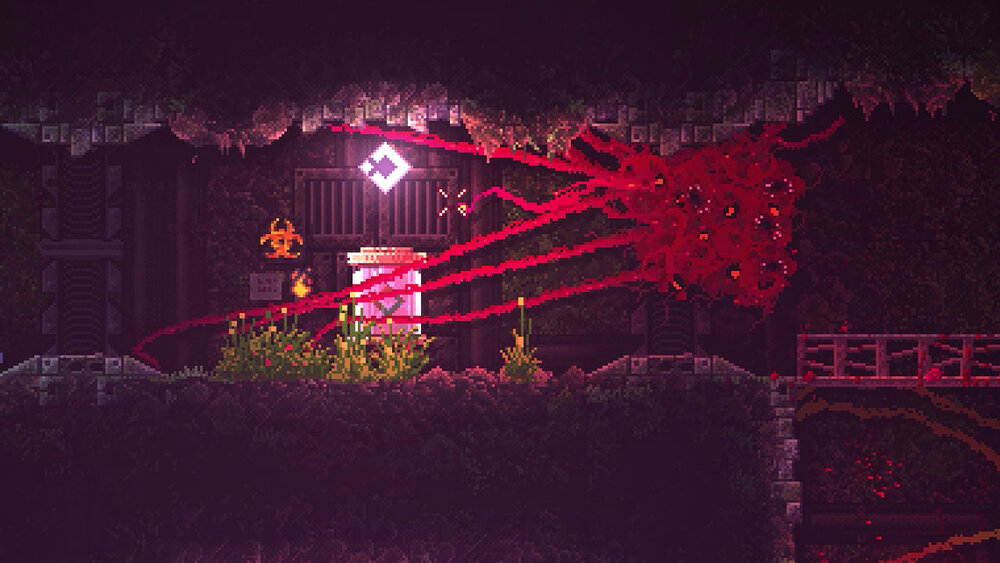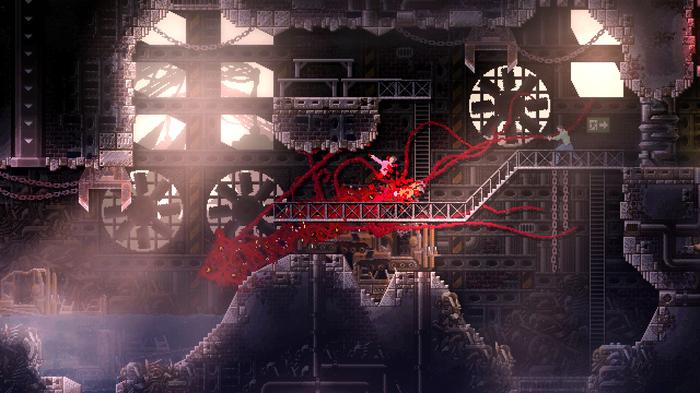In Carrion, you play as Blobby Bobby, a formless bleeding carnivorous mass trying to escape from a half-life-esque endlessly-large underground science laboratory. Where did Blobby Bobby come from? What does he want? Is he an alien or an experiment gone wrong? Who cares?! Let’s kill some nerds.
Blobby Bobby (or BB for short) was without-a-doubt the reason I downloaded this new game. I didn’t look into the gameplay or story at all. I saw the grotesque monster we’d be playing as and purchased it as soon as it was available. Despite my original interest in playing as John Carpenter’s The Thing, after finishing this game, my thoughts about it are mostly concerned with the level design.
This game was being touted as a metroidvania during it’s promotion, but it’s far too linear to truly be compared to games like Hollow Knight. Many are using this as a point of criticism, but I’m actually impressed by the amount of design complexity present in these levels. All of the interlooping twistiness of an entire other metroidvania game is packed into each individual level of Carrion. This linearity reduces the amount of necessary exploration to about zero, but after understanding it’s not meant to be an explorative game, I enjoyed these levels as well-engineered machinery.

What makes Carrion seem from a distance like a metroidvania is that the player is flying up and down and back and forth through the same screens from multiple different routes that open and shut via switches or BB’s newly unlocked abilities. For example, when BB crawls into a vat of biological bad-stuff and develops hydrophobia, he can pass through even tinier cracks than usual when submerged in water. Thus, the same screen that only had limited pathways now grants access to multiple different sections of the level. The screen held secret paths only accessible to a more mature experienced BB.
When BB is a certain size he has certain abilities, therefore making parts of the levels only accessible when BB is the proper girth. Size is managed by BB’s health bar. When BB takes damage his body gets smaller. You can voluntarily deposit some “biomass” at designated red pools at the expense of some health. BB can regain lost mass by consuming people, visiting a save point, or withdrawing his stored biomass from the same pools.
As the player makes their way through these levels they must recognize familiar problems and solutions. If there is a tiny hole with a switch behind it, shoot a web at it as small BB. If there is a large heavy bolt blocking your way hit it as medium BB if it’s facing away from you, or big BB if it’s facing towards you.

The main reason it isn’t a metroidvania is that there is no reason to revisit areas you haven’t been yet. You keep moving forward until you realize you missed something. If this game is played perfectly well, you’d never need to backtrack at all. Metroidvanias thrive in the moments you are lost. Carrion would benefit from you never diverging from the beaten path. To call Carrion a metroidvania is to call it a bad metroidvania. To call it a maze-crawling stealthy puzzle game with a big monster then it’s really good.
The designers must have recognized that backtracking through the level to find dead bodies, biomass drop-off pools, or save points would harm the game’s flow, so one can always find what is needed just before it becomes necessary. This flow creates a sense of trust in what the level presents to you. Whenever I was prodding along through the level and saw an electrical box to charge my secondary ability, I knew, immediately, to charge it, because the next screen would contain a challenge that needed my charged ability.
Whenever I saw a opening I knew it would be best to go through it instead of exploring the rest of the area first, because skipping it would mean missing out on something I would need for the part of the level I hadn’t visited yet. Now, if we’re thinking of Carrion as a metroidvania, this is a terrible sin. But, if you can shake these expectations and learn to accept what the game is giving you, you can find pleasure in the zen-like flow state of near-effortlessly conquering these mazes.
The design almost feels like those top-voted Mario Maker levels where the player puts the controller down to watch Mario fly through complex machinery, so instead of feeling like an unstoppable killing machine, you feel more like Pee-Wee Herman’s breakfast. Because each room has such a specific design layout, there is really only one possible way to approach each area. One problem, one solution. These level designs play out less like puzzles to solve and more like direct paths to traverse through.

That kind of sounded like an insult, but it wasn’t meant to be. In Carrion, the player has to engage with the Pee-Wee Herman breakfast machine in order for it to operate properly. This turns the player into a major part of that machinery, and makes it all an enjoyable experience, if somewhat lacking in player agency.
The flow-state experience of the explorative aspects unfortunately has to come to an end when a dudes with a laser shields shoot you with flamethrowers. At that point, brake-pads get slammed into your thumbs as the gameplay style changes. Suddenly this quick-draw call and response method fails as the game demands strategy. Sometimes flinging BB into the crowd of humans before they can boot up their laser shields will be effective, but often, the only way through is to stealth through hidden passageways and sit in corners, picking off each soldier one-by-one.
The game promotes a knee-jerk reflexive kind of gameplay for one part, then demands the player to boot up their cerebral cortex to think their way through the other. Luckily, the combat sections are incredibly fun and exhilirating. When you stumble into a room full of humans that are better at staying alive, you either decimate them before they can harm you, or have to be thoughtful and sneaky in order to clear out the room. One could see this drastic shift in gameplay style as a complaint, but I think it works with respect to the role-playing. BB is a frantic growing mass that is trying to succeed at world domination sooner rather than later. Coming in contact with militant humans that wont die immediately would probably be a bit frustrating for him.

The only real problem I have with this is that the lack of time spent exploring and backtracking through these levels makes repeating the same sections because of death more annoying than in other explorative games. It was frustrating to start back at the save point, drop off the biomass again, flip off the switch again, go back, pick up the biomass so I can have more health, then go through two screens to get back to the action. Most metroidvanias shine in the way that, if a combat encounter begins to frustrate, you can always just goof around elsewhere for a bit to cool off.
Again, if we put on our good-time hat, this could be seen as a positive for Carrion’s role-playing. You shouldn’t just be throwing yourself senselessly into a conflict with a laser-shielded flamethrower. Blobby Bobby is not a mindless all-consuming mass. If he is intelligent enough to flip switches and quietly open doors, why not plan out his murders as well? Tedious death consequences do force the player to stop and consider the situations before acting, because who said consuming an entire planet’s biological material would be easy?
Another issue is controlling BB, especially as he gets larger. The clumsy flopping around of your giant gelatinous ass makes precision during combat sections even more difficult. But, again, this does put me into the shoes of this big mess of a monster. The frustration felt by the player and the frenetic insanity required to handle the combat does create a special connection between you and Blobby Bobby. I know that the next time I watch John Carpenter’s The Thing, I will now have an empathy for this drippy sickening horrific monster. He’s just doing his best, guys.
